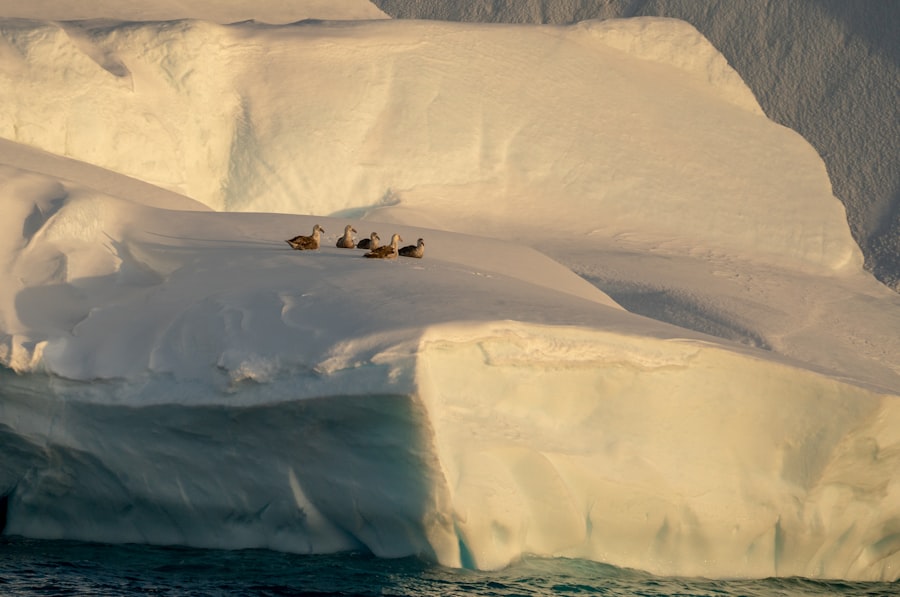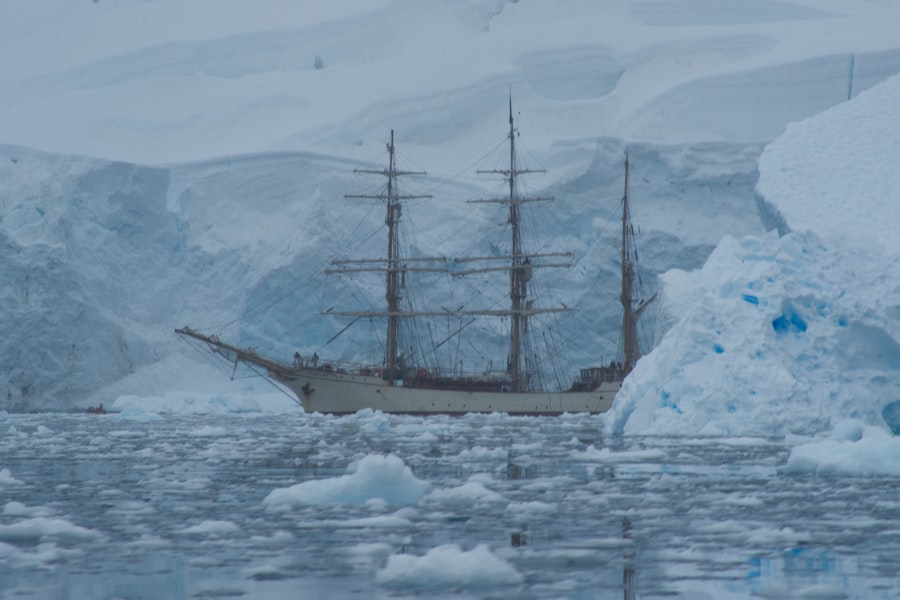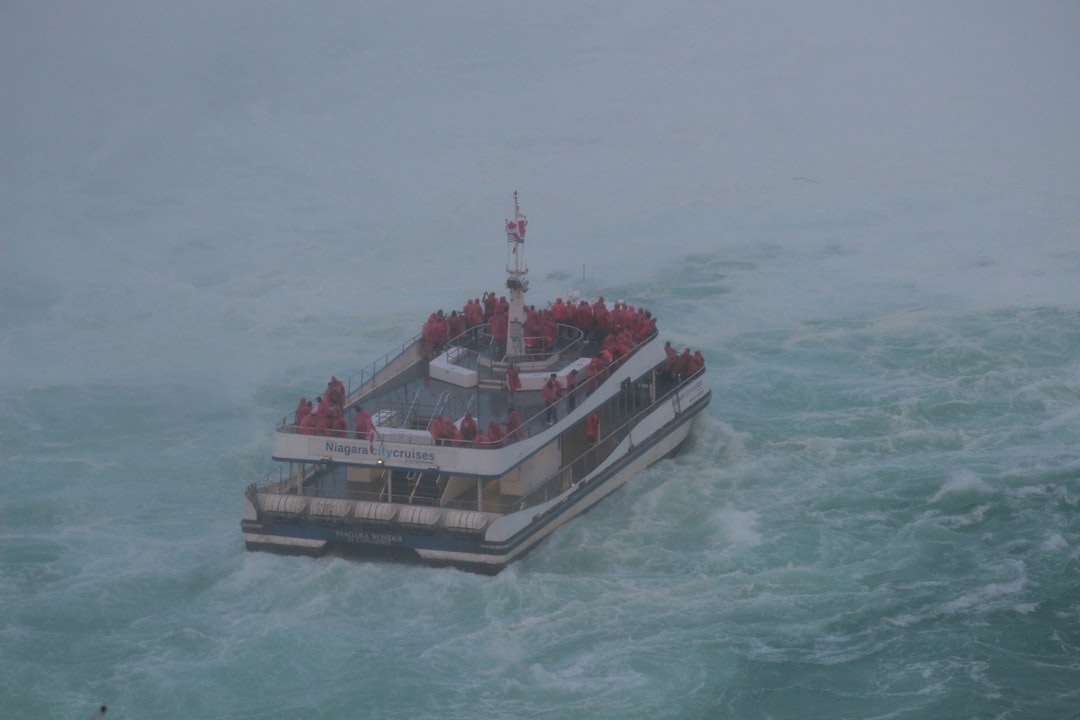The Drake Passage, a body of water situated between the southern tip of South America and Antarctica, is renowned for its tumultuous seas and unpredictable weather. Spanning approximately 800 kilometers (500 miles) in width, it serves as a critical conduit for ocean currents and marine life. The passage is named after Sir Francis Drake, the English explorer who navigated these waters in the late 16th century.
Its strategic location not only connects the Atlantic and Pacific Oceans but also plays a vital role in global climate regulation through the movement of water masses. The geographical features of the Drake Passage contribute to its notoriety among sailors and adventurers alike. The convergence of the Antarctic Circumpolar Current, which flows unimpeded around Antarctica, with the warmer waters from the north creates a unique marine environment.
This interaction results in a dynamic ecosystem that supports a diverse array of wildlife. However, it also leads to some of the roughest seas on the planet, making navigation through the passage both challenging and exhilarating.
Key Takeaways
- The Drake Passage is a narrow body of water between South America’s Cape Horn and the South Shetland Islands of Antarctica, known for its rough seas and strong winds.
- The Drake Passage has a significant historical importance as it was named after the English explorer Sir Francis Drake and has been a key route for maritime exploration and trade.
- The weather in the Drake Passage is characterized by strong winds, high waves, and rapidly changing conditions, making it one of the most challenging maritime environments in the world.
- The Drake Passage is home to a diverse range of wildlife, including penguins, seals, and various species of whales, making it a popular destination for wildlife enthusiasts and researchers.
- Navigating the Drake Passage poses significant challenges for ships and requires careful planning and experienced crew to ensure safe passage.
Historical Significance of the Drake Passage
Historically, the Drake Passage has been a significant route for explorers and traders seeking to navigate between the Atlantic and Pacific Oceans. In the age of exploration, it represented both a perilous challenge and an opportunity for discovery. Sir Francis Drake’s circumnavigation of the globe in the late 1500s marked one of the first recorded passages through these treacherous waters, solidifying its place in maritime history.
His journey not only showcased his navigational skills but also opened up new trade routes and opportunities for European powers. The passage has also played a crucial role in scientific exploration. In the 19th century, it became a focal point for researchers studying oceanography and marine biology.
The unique conditions of the Drake Passage have attracted scientists eager to understand its complex ecosystems and the impact of climate change on these fragile environments. As such, it has become a site of both historical exploration and contemporary scientific inquiry.
Weather and Climate in the Drake Passage

The weather in the Drake Passage is notoriously unpredictable, characterized by rapidly changing conditions that can shift from calm to stormy within moments. The region experiences strong winds, particularly during the winter months, which can create towering waves and hazardous sailing conditions. The average temperature ranges from -2°C (28°F) in winter to 10°C (50°F) in summer, but these figures can vary significantly due to local weather patterns.
The climate is influenced by several factors, including the proximity to Antarctica and the surrounding ocean currents. The cold waters of the Southern Ocean collide with warmer air masses from the north, resulting in frequent storms and fog. Sailors traversing this passage must be prepared for sudden changes in weather, as conditions can deteriorate rapidly, making it essential to monitor forecasts closely.
Wildlife and Marine Life in the Drake Passage
| Category | Metrics |
|---|---|
| Whales | Several species of whales, including humpback, minke, and orca, can be found in the Drake Passage. |
| Penguins | Large colonies of penguins, such as chinstrap and gentoo, inhabit the islands and shores of the Drake Passage. |
| Seals | Various species of seals, including leopard seals and Weddell seals, can be spotted in the waters and on the ice floes of the Drake Passage. |
| Albatross | The Drake Passage is home to several species of albatross, known for their impressive wingspans and graceful flight. |
| Fish | The waters of the Drake Passage are rich in marine life, including a variety of fish species that support the diverse ecosystem. |
The Drake Passage is home to an astonishing variety of wildlife, making it a prime destination for nature enthusiasts and researchers alike. The nutrient-rich waters support an abundance of marine life, including krill, which serves as a crucial food source for many species. This rich ecosystem attracts numerous seabirds, such as albatrosses and petrels, which can often be seen gliding gracefully above the waves.
In addition to avian life, the passage is frequented by various marine mammals, including whales and seals. Species such as humpback whales, orcas, and southern right whales migrate through these waters, drawn by the plentiful food supply. The sighting of these majestic creatures is a highlight for many travelers crossing the Drake Passage, offering a glimpse into the vibrant life that thrives in this remote region.
Navigational Challenges in the Drake Passage
Navigating the Drake Passage presents numerous challenges for even the most experienced sailors. The combination of strong currents, unpredictable weather patterns, and shifting icebergs creates a formidable environment that demands respect and caution. The passage is known for its rough seas, with waves reaching heights of up to 15 meters (49 feet) during storms, making it essential for vessels to be well-equipped and prepared for adverse conditions.
Moreover, the lack of safe harbors along the route adds to the complexity of navigation. Once committed to crossing the passage, vessels must be able to endure whatever challenges arise until they reach their destination. This aspect of sailing through the Drake Passage requires not only skill but also a deep understanding of maritime navigation techniques and an ability to read changing weather patterns effectively.
Safety Precautions for Crossing the Drake Passage

Given its reputation for treacherous conditions, safety precautions are paramount when crossing the Drake Passage. Mariners are advised to conduct thorough preparations before embarking on their journey.
Regular maintenance checks are crucial to ensure that all systems are functioning optimally. Additionally, understanding weather patterns and being able to interpret forecasts is vital for safe navigation. Many experienced sailors recommend waiting for favorable weather windows before attempting to cross.
It is also advisable to travel in groups or as part of an organized expedition where experienced guides can provide support and expertise throughout the journey.
Popular Routes and Itineraries through the Drake Passage
Several popular routes traverse the Drake Passage, catering to different types of travelers and their interests. One of the most well-known itineraries is the journey from Ushuaia, Argentina, to various destinations in Antarctica. This route typically takes travelers across the passage in search of breathtaking landscapes and unique wildlife experiences.
Another popular option includes cruises that explore both sides of the passage, allowing passengers to experience both South America’s rugged coastline and Antarctica’s pristine wilderness. These itineraries often include stops at various islands along the way, providing opportunities for excursions such as hiking, kayaking, and wildlife watching. Each route offers its own unique perspective on this remarkable region.
Famous Expeditions and Explorations in the Drake Passage
Throughout history, numerous expeditions have ventured into the Drake Passage, each contributing to our understanding of this challenging environment. One notable expedition was led by Ernest Shackleton during his ill-fated attempt to cross Antarctica in 1914. His journey through these waters became legendary not only for its challenges but also for Shackleton’s remarkable leadership and survival skills.
In more recent times, scientific expeditions have focused on studying climate change’s impact on marine ecosystems within the passage. Researchers have conducted extensive surveys to monitor changes in wildlife populations and oceanographic conditions over time. These expeditions have provided invaluable data that informs conservation efforts and enhances our understanding of this vital marine environment.
Tips for Surviving the Drake Passage
For those planning to cross the Drake Passage, several tips can enhance their experience and increase safety. First and foremost, travelers should dress in layers to accommodate fluctuating temperatures and wet conditions.
Additionally, staying hydrated and well-nourished is crucial during the crossing. Many travelers find that consuming light meals helps prevent seasickness while providing necessary energy levels. It is also advisable to familiarize oneself with motion sickness remedies before embarking on this journey; many find that over-the-counter medications or natural remedies can be beneficial.
The Future of Travel through the Drake Passage
As interest in Antarctic travel continues to grow, so too does concern for preserving the delicate ecosystems within the Drake Passage. Sustainable tourism practices are becoming increasingly important as more vessels navigate these waters. Operators are encouraged to adhere to strict environmental guidelines that minimize their impact on wildlife and habitats.
The future may also see advancements in technology that enhance safety and navigation through this challenging region. Innovations such as improved weather forecasting systems and more resilient vessel designs could make crossings safer while allowing travelers to experience this remarkable area with greater confidence.
Personal Stories and Experiences of Crossing the Drake Passage
Personal accounts from those who have crossed the Drake Passage often highlight both its challenges and rewards. Many travelers recount feelings of exhilaration mixed with trepidation as they faced towering waves and fierce winds during their journey. Yet these experiences are often accompanied by awe-inspiring moments—sightings of whales breaching nearby or flocks of seabirds soaring overhead.
For some adventurers, crossing the Drake Passage becomes a rite of passage—a testament to their spirit of exploration and resilience against nature’s forces. These stories serve as reminders that while navigating this formidable body of water can be daunting, it also offers unparalleled opportunities for connection with nature and discovery of one’s own limits.
Crossing the Drake Passage is often considered one of the most challenging maritime journeys due to its unpredictable weather and rough seas. This treacherous stretch of water, located between the southern tip of South America and Antarctica, is notorious for its strong currents and high waves, which can pose significant risks to even the most experienced sailors. For those interested in learning more about the challenges and adventures associated with navigating this formidable passage, a related article can be found on MyGeoQuest. This article provides insights into the experiences of those who have braved the Drake Passage and offers tips for those considering the journey. You can read more about it by visiting this page.
WATCH NOW! Drake Passage: Earth’s Deadliest Waters Revealed
FAQs
What is the Drake Passage?
The Drake Passage is the body of water between the southern tip of South America and the northern tip of the Antarctic Peninsula. It is known for its rough seas and challenging sailing conditions.
Is crossing the Drake Passage dangerous?
Crossing the Drake Passage can be dangerous due to its unpredictable weather, strong winds, and rough seas. It is often referred to as one of the most treacherous sea crossings in the world.
What are the main risks of crossing the Drake Passage?
The main risks of crossing the Drake Passage include extreme weather conditions, high winds, large waves, and the potential for icebergs. These factors can make navigation and sailing challenging and hazardous.
Are there safety measures in place for crossing the Drake Passage?
Experienced captains and crew members, as well as modern navigation and communication equipment, are essential safety measures for crossing the Drake Passage. Many expeditions and cruises also have ice-strengthened vessels to navigate the icy waters.
Are there alternatives to crossing the Drake Passage?
Some travelers opt for flying to or from Antarctica instead of crossing the Drake Passage by sea. This eliminates the risks associated with the challenging sea conditions.
